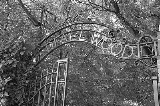
Coldfall wood
Encyclopedia
Coldfall Wood is an ancient wood in Muswell Hill
, North London
. It covers an area of approximately 14 hectares and is surrounded by the St. Pancras and Islington Cemetery
, the East Finchley
public allotments, and the residential roads Creighton Avenue and Barrenger Road. It is the site of the discoveries which first led to the recognition that glaciation had once reached southern England.
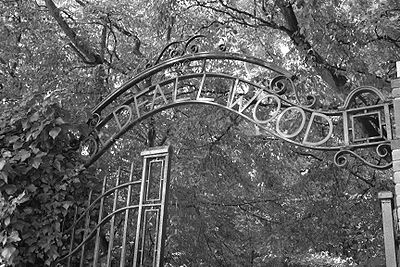 The London Borough of Haringey
The London Borough of Haringey
contains four ancient woods: Highgate Wood
, Queen's Wood
, Coldfall Wood, Bluebell Wood
. All are shown on John Rocque
's 1754 Map of Middlesex
.
Until the early 20th century Coldfall Wood covered more than twice its current extent, reaching south to the properties bordering Fortis Green
. The southern section was felled and partially excavated for gravel, before being used for residential development and the sites of Tollington and William Grimshaw schools (later Fortismere School
). Tollington first rented and felled part of the wood for a sports field in the 1920s and subsequently moved to a new building on the site. William Grimshaw was built later to the north.
Coldfall Wood was purchased in 1930 by Hornsey Council
and the remaining section is now owned and managed by its successor, the London Borough of Haringey
. It is bounded to the North by the St. Pancras and Islington Cemetery
and the Muswell Hill Sports Ground (formerly Finchley Common
). Its western boundary is the boundary line between the London Boroughs of Barnet
and Haringey
. This western boundary and its northern boundaries are demarcated by the remains of an ancient woodbank with a ditch on the outer side. This would have prevented grazing animals from the surrounding Finchley Common
and Horseshoe Farm (as they then were) from entering the wood and destroying the young coppice.
Coldfall Wood has been examined in some detail by Silvertown (1978), who used historical sources to show that the woodlands are likely to be of primary origin (i.e. continuously present since prehistoric times).
In March 2011, the Friends of Coldfall Wood launched an online interactive map that included historical maps of the area overlaid on a modern streetmap, showing how the wood has dwindled in size since 1864.
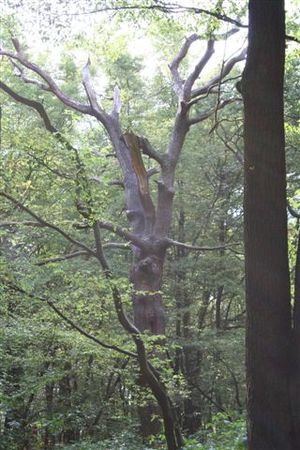 Like the other local ancient woodland
Like the other local ancient woodland
s in the area, the Wood is dominated by oak
standards, but the understorey is much less diverse and consists of almost pure stands of multi-stemmed, overgrown hornbeam
coppice. Beech
, hazel
, mountain ash
and Wild Service Tree
are all rare, though there are some fine specimens of the last species.
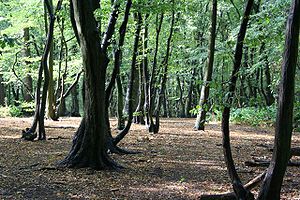 Little light penetrates to the woodland floor in the most wooded places and large areas of the Wood are devoid of either shrub, field or ground layers of vegetation. Consequently parts of the Wood can present a dark and gloomy appearance in the summer months. Nevertheless, in the few glade areas caused by the collapse of an occasional canopy tree, or by more recent coppicing, the flora is of considerable interest. Pill sedge
Little light penetrates to the woodland floor in the most wooded places and large areas of the Wood are devoid of either shrub, field or ground layers of vegetation. Consequently parts of the Wood can present a dark and gloomy appearance in the summer months. Nevertheless, in the few glade areas caused by the collapse of an occasional canopy tree, or by more recent coppicing, the flora is of considerable interest. Pill sedge
hangs on in its only known Haringey site and tiny populations of cow-wheat
, slender St. John's wort, wood anemone
, and heath speedwell
manage to survive though they seldom flower.
An area of approximately one acre
was cut in the north western corner of the Wood in December 1990 with the assistance of the British Trust for Conservation Volunteers, the Friends of Coldfall Wood and the Haringey Branch of the London Wildlife Trust
. The felled hornbeam poles were cut, stacked on site and allowed to decay in situ to provide deadwood habitat for the benefit of invertebrate
s and fungi. Brushwood was used to construct a dead hedge around the coppice. This has protected the area from trampling, both by dogs and humans, and will hopefully provide a nesting habitat for wrens
and other woodland birds. Regrowth from the cut hornbeam stools has been encouraging with a maximum growth of 2 metres being recorded by the end of 1991.
The vegetational succession following the coppice is being carefully monitored by means of permanent quadrats. In the first year after coppicing, more than seventy species of flowering plant have been recorded here - a gratifying increase from the original flora of a mere six species. The newcomers include heath groundsel
which is unknown elsewhere in the Borough, suggesting the possibility that its seed may have lain dormant in the soil since the last coppice was cut before the last World War. Ring counts of the coppice poles suggest that this was done about sixty years ago. The majority of new plants, however, will have colonised from outside and many of the arrivals are widespread ruderal species typical of disturbed open habitats, such as mugwort
, sow-thistles
and willowherbs
. Rosebay willowherb
dominates much of the area. A hundred years ago this was a rare plant in southern England
and it is noteworthy that it was recorded from Coldfall Wood as early as 1901 (Kent 1975). The appearance of Sumatran fleabane was not entirely unexpected, for it has spread rapidly throughout Haringey since first being recorded from the Borough in 1985 (Wurzell 1988). It is also present in North Wood. There can be few other ancient woods in Britain which include this subtropical species in their flora.
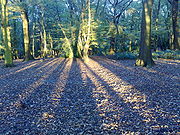 The wood lies on the northern margin of the glacial ridge that forms Muswell Hill. The surviving section of the wood lies on London Clay
The wood lies on the northern margin of the glacial ridge that forms Muswell Hill. The surviving section of the wood lies on London Clay
overlain by head
. To the immediate west and south this is overlain by gravels of a former course of the Thames, capped by glacial till
of Anglian age. It was here in 1835 that N.T.Wetherell
discovered a strange mixture of rocks and fossils normally found in the north of England that led to the subsequent recognition of glacial deposits in southern England.
(HLF) which has been prepared by a range of partners, including the Greater London Authority
, the Forestry Commission
, and several London Boroughs including Haringey. The bid is being taken forward by Trees for Cities
.
The improvement programme consists of the following projects over a 3-year timeframe.
Muswell Hill
Muswell Hill is a suburb of north London, mostly in the London Borough of Haringey. It is situated about north of Charing Cross and around from the City of London. Muswell Hill is in the N10 postal district and mostly in the Hornsey and Wood Green parliamentary constituency.- History :The...
, North London
North London
North London is the northern part of London, England. It is an imprecise description and the area it covers is defined differently for a range of purposes. Common to these definitions is that it includes districts located north of the River Thames and is used in comparison with South...
. It covers an area of approximately 14 hectares and is surrounded by the St. Pancras and Islington Cemetery
St. Pancras and Islington Cemetery
The St. Pancras and Islington Cemetery in East Finchley, North London while situated in the London Borough of Barnet is actually two cemeteries, owned by two other London Boroughs, Camden and Islington...
, the East Finchley
East Finchley
East Finchley is a suburb in the London Borough of Barnet, in north London, and situated north-west of Charing Cross. Geographically it is somewhat separate from the rest of Finchley, with North Finchley and West Finchley to the north, and Finchley Central to the west.- History :The land on which...
public allotments, and the residential roads Creighton Avenue and Barrenger Road. It is the site of the discoveries which first led to the recognition that glaciation had once reached southern England.
History

London Borough of Haringey
The London Borough of Haringey is a London borough, in North London, classified by some definitions as part of Inner London, and by others as part of Outer London. It was created in 1965 by the amalgamation of three former boroughs. It shares borders with six other London boroughs...
contains four ancient woods: Highgate Wood
Highgate Wood
Highgate Wood is a 28 hectare area of ancient woodland in North London, lying between East Finchley, Highgate Village, and Muswell Hill. It was originally part of the ancient Forest of Middlesex which covered much of London, Hertfordshire and Essex and was mentioned in the Domesday Book...
, Queen's Wood
Queen's Wood
Queen's Wood is a 21 hectare area of ancient woodland in North London, abutting Highgate Wood and lying between East Finchley, Highgate Village, Muswell Hill and Crouch End...
, Coldfall Wood, Bluebell Wood
Bluebell Wood, London
Bluebell Wood in the London Borough of Haringey is a small remnant of one of the ancient woodlands of London. It is situated at the end of Winton Avenue and is bordered by Muswell Hill golf course, Winton Avenue and allotments. It is open at all times and is a popular place for local people to walk...
. All are shown on John Rocque
John Rocque
John Rocque was a surveyor and cartographer.Rocque was born no later than 1709, since that was the year he moved to England with his parents, who were French Huguenot émigrés...
's 1754 Map of Middlesex
Middlesex
Middlesex is one of the historic counties of England and the second smallest by area. The low-lying county contained the wealthy and politically independent City of London on its southern boundary and was dominated by it from a very early time...
.
Until the early 20th century Coldfall Wood covered more than twice its current extent, reaching south to the properties bordering Fortis Green
Fortis Green
Fortis Green is a ward in the extreme north-western corner of the Borough of Haringey, North London. It is also the name of the road that runs between Muswell Hill and East Finchley which forms part of the A504....
. The southern section was felled and partially excavated for gravel, before being used for residential development and the sites of Tollington and William Grimshaw schools (later Fortismere School
Fortismere School
Fortismere School is a mixed, community foundation secondary school in Muswell Hill, London, United Kingdom.-Admissions:It falls under the London Borough of Haringey Local Education Authority...
). Tollington first rented and felled part of the wood for a sports field in the 1920s and subsequently moved to a new building on the site. William Grimshaw was built later to the north.
Coldfall Wood was purchased in 1930 by Hornsey Council
Municipal Borough of Hornsey
Hornsey was a local government district in east Middlesex from 1867 to 1965.In 1867, a Local Board was formed for part of the civil parish of Hornsey. The rest of the parish was already under South Hornsey Local Board formed in 1865....
and the remaining section is now owned and managed by its successor, the London Borough of Haringey
London Borough of Haringey
The London Borough of Haringey is a London borough, in North London, classified by some definitions as part of Inner London, and by others as part of Outer London. It was created in 1965 by the amalgamation of three former boroughs. It shares borders with six other London boroughs...
. It is bounded to the North by the St. Pancras and Islington Cemetery
St. Pancras and Islington Cemetery
The St. Pancras and Islington Cemetery in East Finchley, North London while situated in the London Borough of Barnet is actually two cemeteries, owned by two other London Boroughs, Camden and Islington...
and the Muswell Hill Sports Ground (formerly Finchley Common
Finchley Common
Finchley Common was an area of land in Middlesex, and until 1816 the boundary between the parishes of Finchley, Friern Barnet and Hornsey.- History :...
). Its western boundary is the boundary line between the London Boroughs of Barnet
London Borough of Barnet
The London Borough of Barnet is a London borough in North London and forms part of Outer London. It has a population of 331,500 and covers . It borders Hertfordshire to the north and five other London boroughs: Harrow and Brent to the west, Camden and Haringey to the south-east and Enfield to the...
and Haringey
London Borough of Haringey
The London Borough of Haringey is a London borough, in North London, classified by some definitions as part of Inner London, and by others as part of Outer London. It was created in 1965 by the amalgamation of three former boroughs. It shares borders with six other London boroughs...
. This western boundary and its northern boundaries are demarcated by the remains of an ancient woodbank with a ditch on the outer side. This would have prevented grazing animals from the surrounding Finchley Common
Finchley Common
Finchley Common was an area of land in Middlesex, and until 1816 the boundary between the parishes of Finchley, Friern Barnet and Hornsey.- History :...
and Horseshoe Farm (as they then were) from entering the wood and destroying the young coppice.
Coldfall Wood has been examined in some detail by Silvertown (1978), who used historical sources to show that the woodlands are likely to be of primary origin (i.e. continuously present since prehistoric times).
In March 2011, the Friends of Coldfall Wood launched an online interactive map that included historical maps of the area overlaid on a modern streetmap, showing how the wood has dwindled in size since 1864.
Flora

Ancient woodland
Ancient woodland is a term used in the United Kingdom to refer specifically to woodland that has existed continuously since 1600 or before in England and Wales . Before those dates, planting of new woodland was uncommon, so a wood present in 1600 was likely to have developed naturally...
s in the area, the Wood is dominated by oak
Oak
An oak is a tree or shrub in the genus Quercus , of which about 600 species exist. "Oak" may also appear in the names of species in related genera, notably Lithocarpus...
standards, but the understorey is much less diverse and consists of almost pure stands of multi-stemmed, overgrown hornbeam
Hornbeam
Hornbeams are relatively small hardwood trees in the genus Carpinus . Though some botanists grouped them with the hazels and hop-hornbeams in a segregate family, Corylaceae, modern botanists place the hornbeams in the birch subfamily Coryloideae...
coppice. Beech
Beech
Beech is a genus of ten species of deciduous trees in the family Fagaceae, native to temperate Europe, Asia and North America.-Habit:...
, hazel
Hazel
The hazels are a genus of deciduous trees and large shrubs native to the temperate northern hemisphere. The genus is usually placed in the birch family Betulaceae, though some botanists split the hazels into a separate family Corylaceae.They have simple, rounded leaves with double-serrate margins...
, mountain ash
Sorbus aucuparia
Sorbus aucuparia , is a species of the genus Sorbus, native to most of Europe except for the far south, and northern Asia...
and Wild Service Tree
Wild Service Tree
Sorbus torminalis , sometimes known as the Chequer Tree or Checker Tree, is a species of Sorbus native to Europe from England and Wales east to Denmark and Poland, south to northwest Africa, and southeast to southwest Asia from Asia Minor to the Caucasus and Alborz mountains.It is a medium-sized...
are all rare, though there are some fine specimens of the last species.

Carex pilulifera
Carex pilulifera is a European species of sedge found in acid heaths, woods and grassland from Macaronesia to Scandinavia. It grows up to tall, with 2–4 female spikes and 1 male spike in an inflorescence...
hangs on in its only known Haringey site and tiny populations of cow-wheat
Melampyrum
Melampyrum is a genus of about 10-20 species of herbaceous flowering plants in the family Orobanchaceae, native to temperate regions of the Northern Hemisphere...
, slender St. John's wort, wood anemone
Anemone nemorosa
Anemone nemorosa is an early-spring flowering plant in the genus Anemone in the family Ranunculaceae, native to Europe. Common names include wood anemone, windflower, thimbleweed and smell fox, an allusion to the musky smell of the leaves...
, and heath speedwell
Veronica officinalis
Veronica officinalis is a species of Veronica, native to Europe and western Asia....
manage to survive though they seldom flower.
An area of approximately one acre
Acre
The acre is a unit of area in a number of different systems, including the imperial and U.S. customary systems. The most commonly used acres today are the international acre and, in the United States, the survey acre. The most common use of the acre is to measure tracts of land.The acre is related...
was cut in the north western corner of the Wood in December 1990 with the assistance of the British Trust for Conservation Volunteers, the Friends of Coldfall Wood and the Haringey Branch of the London Wildlife Trust
London Wildlife Trust
London Wildlife Trust was founded in 1981. It is one of 47 members of the Royal Society of Wildlife Trusts , each of which is a local nature conservation charity for its area....
. The felled hornbeam poles were cut, stacked on site and allowed to decay in situ to provide deadwood habitat for the benefit of invertebrate
Invertebrate
An invertebrate is an animal without a backbone. The group includes 97% of all animal species – all animals except those in the chordate subphylum Vertebrata .Invertebrates form a paraphyletic group...
s and fungi. Brushwood was used to construct a dead hedge around the coppice. This has protected the area from trampling, both by dogs and humans, and will hopefully provide a nesting habitat for wrens
Eurasian Wren
The Eurasian Wren , is a very small bird, and the only member of the wren family Troglodytidae found in Eurasia. In Anglophone Europe it is commonly known simply as the Wren...
and other woodland birds. Regrowth from the cut hornbeam stools has been encouraging with a maximum growth of 2 metres being recorded by the end of 1991.
The vegetational succession following the coppice is being carefully monitored by means of permanent quadrats. In the first year after coppicing, more than seventy species of flowering plant have been recorded here - a gratifying increase from the original flora of a mere six species. The newcomers include heath groundsel
Senecio sylvaticus
Senecio sylvaticus is a species of flowering plant in the aster family known by the common name woodland ragwort and heath groundsel. It is native to Eurasia, and it can be found in other places, including western and eastern sections of North America, as an introduced species and an occasional...
which is unknown elsewhere in the Borough, suggesting the possibility that its seed may have lain dormant in the soil since the last coppice was cut before the last World War. Ring counts of the coppice poles suggest that this was done about sixty years ago. The majority of new plants, however, will have colonised from outside and many of the arrivals are widespread ruderal species typical of disturbed open habitats, such as mugwort
Artemisia vulgaris
Artemisia vulgaris is one of several species in the genus Artemisia which have common names that include the word mugwort. This species is also occasionally known as Felon Herb, Chrysanthemum Weed, Wild Wormwood, Old uncle Henry, Sailor's Tobacco, Naughty Man, Old Man or St...
, sow-thistles
Sonchus
Sonchus is a genus of flowering plants in the daisy family Asteraceae. Most of the species are annual herbs, a few are perennial, and some are even woody...
and willowherbs
Epilobium
Epilobium is a genus in the family Onagraceae, containing about 160-200 species of flowering plants with a worldwide distribution. They are generally abundant in the subarctic, temperate and subantarctic regions, whereas in the subtropics and tropics they are restricted to the cool montane biomes,...
. Rosebay willowherb
Fireweed
Epilobium angustifolium, commonly known as Fireweed , Great Willow-herb , or Rosebay Willowherb , is a perennial herbaceous plant in the willowherb family Onagraceae...
dominates much of the area. A hundred years ago this was a rare plant in southern England
England
England is a country that is part of the United Kingdom. It shares land borders with Scotland to the north and Wales to the west; the Irish Sea is to the north west, the Celtic Sea to the south west, with the North Sea to the east and the English Channel to the south separating it from continental...
and it is noteworthy that it was recorded from Coldfall Wood as early as 1901 (Kent 1975). The appearance of Sumatran fleabane was not entirely unexpected, for it has spread rapidly throughout Haringey since first being recorded from the Borough in 1985 (Wurzell 1988). It is also present in North Wood. There can be few other ancient woods in Britain which include this subtropical species in their flora.
Geology

London Clay
The London Clay Formation is a marine geological formation of Ypresian age which crops out in the southeast of England. The London Clay is well known for the fossils it contains. The fossils from the Lower Eocene indicate a moderately warm climate, the flora being tropical or subtropical...
overlain by head
Head (geological)
Head describes deposits at the very top of the geological succession, that could not be classified more accurately. The term has been used by British geologists since the middle of the 19th century...
. To the immediate west and south this is overlain by gravels of a former course of the Thames, capped by glacial till
Till
thumb|right|Closeup of glacial till. Note that the larger grains in the till are completely surrounded by the matrix of finer material , and this characteristic, known as matrix support, is diagnostic of till....
of Anglian age. It was here in 1835 that N.T.Wetherell
Nathaniel Wetherell
Dr. Nathaniel Thomas Wetherell MRCS FGS was a British geologist and surgeon. His work involved the collection of various fossils found in England. He was born, lived, and died in Highgate, England....
discovered a strange mixture of rocks and fossils normally found in the north of England that led to the subsequent recognition of glacial deposits in southern England.
Future projects
Coldfall Wood has been selected as one of six "Flagship Woods" in the whole of London, to be included as part of the "Capital Woodlands Project" application to the Heritage Lottery FundHeritage Lottery Fund
The Heritage Lottery Fund is a fund established in the United Kingdom under the National Lottery etc. Act 1993. The Fund opened for applications in 1994. It uses money raised through the National Lottery to transform and sustain the UK’s heritage...
(HLF) which has been prepared by a range of partners, including the Greater London Authority
Greater London Authority
The Greater London Authority is the top-tier administrative body for Greater London, England. It consists of a directly elected executive Mayor of London, currently Boris Johnson, and an elected 25-member London Assembly with scrutiny powers...
, the Forestry Commission
Forestry Commission
The Forestry Commission is a non-ministerial government department responsible for forestry in Great Britain. Its mission is to protect and expand Britain's forests and woodlands and increase their value to society and the environment....
, and several London Boroughs including Haringey. The bid is being taken forward by Trees for Cities
Trees for Cities
-History:The charity was founded in 1993, initially as Trees for London to "advance the education of the public in the appreciation of trees and their amenity value, and in furtherance of this the planting and protection of trees everywhere, and in particular inner city areas"...
.
The improvement programme consists of the following projects over a 3-year timeframe.
- Coppicing – to commence in November 2006
- Building two new bridges across the brook and installing 6 new benches and a picnic bench
- Reed bed – works to start around Christmas 2006. There will be 5 dams constructed with wood from the coppicing.
- Improved access through the various entry gates.
External links
- Haringey Council: Coldfall Wood
- Haringey Council: Coldfall Wood Nature Trail
- Friends of Coldfall Wood
- Coldfall Wood on the VisitWoods website

